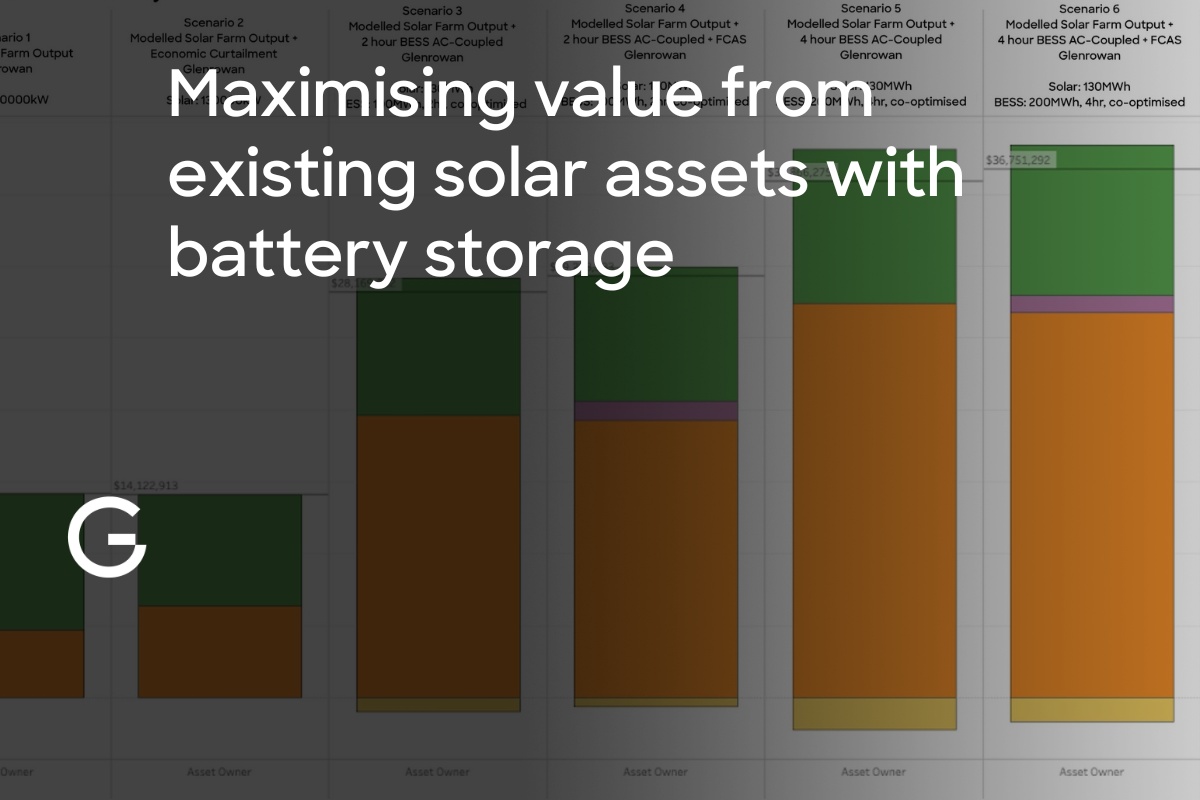Volume and Shape: Understanding the cost of electricity and the value of flexibility
.png)
Most electricity users focus on how much electricity they use when they want to reduce costs. This is called volume, measured in kilowatt-hours (kWh).
But when and how electricity is used – shape – often has a much bigger impact on cost (and potentially also on emissions).
Renewable energy systems and flexible energy resources like batteries can radically change load shape, so understanding shape is vital to understanding the case for energy investment.
Where Prices Come From
In wholesale electricity markets, the price of electricity is set at a granular interval level (ranging from every five minutes to every hour, depending on the market).
These prices typically reflect the cost of the most expensive generator needed to meet demand in each trading interval. Prices change constantly due to fluctuations in energy consumption, generator availability, fuel costs, weather (available renewable resources), and network constraints.
Prices can and do go negative when generation is surplus to demand, and when there is generation that can't or won’t turn‑down in response to market price signals.
This could be generators like coal or nuclear plants that lack flexibility, or generators like solar or wind that often have ‘out‑of‑the‑market’ government support schemes or power purchase agreements that mean they can still generate profitably when the market is signalling that there is too much generation.
The role of electricity retailers is to manage price variability on behalf of customers, and allow customers to contract firm electricity prices in advance to avoid risk. So they carefully manage the relationship between electricity prices and their customers’ load shapes when pricing electricity supply.
Load Shape
Load shape refers to how a customer uses electricity over time. Some customers have a flat load. Others have sharp peaks. Their usage may be predictable, weather dependent, or highly variable.
Let’s consider a few examples.
- Residential Customer: Uses most electricity in the morning and evening. These times often align with high wholesale prices, especially in systems with high solar generation during the day. Often the shape of residential customer loads set the overall peak demand for the power system and the times of highest power prices.
- Shopping Center: Has an HVAC-dominant (temperature‑dependent) load that is well aligned with daily solar generation profiles, and which is generally contra‑positioned against residential customer loads that drive peak pricing.
- Data Center: Have a flat and steady load, operating 24/7 meaning they use power during both low and high price periods. The overall pricing impact is that their load shape is neutral and their predictable demand is low risk, from a wholesale exposure standpoint
- Glass Manufacturer: Operates high‑load electric furnaces in batches creating sharp peaks in usage. If not managed well these peaks could coincide with high system peaks, leading to higher costs due to demand charges and wholesale exposure.
Retail electricity prices are built up from wholesale prices, system costs, environmental charges including cost recovery for renewable support schemes, market fees, and hedging costs, and sometimes also network charges, when these are bundled into retail supply contracts.
Retailers set prices based on the expected cost of serving each customer’s load shape plus some margin requirement, taking into account their forward view of wholesale prices, the shape of their overall customer book (a diversity of load shapes is desirable, giving larger retailers a competitive advantage over smaller retailers), their current wholesale contracting position, and a risk or volatility premium to cover hedging costs (the cost of purchasing contracts to cover the risk of extreme pricing events).
Two customers may use the same amount of electricity, but pay very different costs for this supplied volume because of how prices vary over time, and because consumption during high‑price periods costs more, and more variable consumption can be more expensive to hedge.
Retailers and networks incentivise flatter, off‑peak usage profiles in their pricing. Customers who understand this and who have more flexible loads can access better pricing and avoid costly demand charges.
Running some numbers
By way of an example, let’s examine the four archetypal load shapes mentioned above, in the context of the Wholesale Energy Market (WEM) in Western Australia.
It’s worth noting in advance that the South-West Interconnected System (SWIS) covered by the WEM has very high roof‑top solar penetration and summer evening peak demand charges linked to a capacity market.
This means electricity prices are low in the middle of the day, and high in the late afternoon and early evening when solar generation ramps down, and system peaks occur.
For this analysis we modelled each site across three scenarios:
- Baseline with a consistent annual volume (55.8 GWh per year),
- Addition of Solar (11.7 MWdc rooftop solar PV), and
- Addition of Storage (the same PV plus a 4 MW / 4 h battery; 16MWh of storage).
Because all modelled load shapes have the same annual volume and we are modelling the addition of the same sized energy resources, all of the commercial differences discussed below are purely caused by shape.
Understanding baseline costs
Despite a consistent annual volume the electricity retailer’s indicative costs vary significantly between these four load profiles, as shown in the analysis below from Gridcog.

For our baseline scenario we are considering wholesale energy costs, system peak demand costs (IRCR), environmental costs (SREC and LREC), and market operator fees.
We’re excluding transmission and distribution costs because these will apply quite differently to our four archetypes. The retail margin shown in the analysis is inclusive of administrative costs, hedging costs, and profit margin.
As a consequence of the variability in the cost stack between load shapes, the corresponding indicative retail pricing the Retailer would need to offer varies considerably also.

And as a consequence of that, customers’ costs vary considerably too. There is an almost $4.5 million dollar variance between the least cost commercial load shape and the highest cost residential portfolio load shape, despite having the same annual volume.

Adding solar
Today, one of the classic consumer responses to high electricity costs is to add roof-top solar.
In this case we’ll add 11.7 MWdc to each load shape, keeping our annual volumes consistent. While solar will reduce electricity imports and increase electricity exports, the value of this change will vary considerably across our four load archetypes, as shown in the analysis below. As a result, retailers’ will re-price these load shapes the next time they come to contract.
This re-pricing risk is something that is universally ignored in the sales focused modelling tools used to assess the roof-top solar business case for consumers, serving to artificially inflate the returns that are presented (often further inflated by unrealistic future price indexing).

While solar has reduced costs across all load shapes, the reductions are fairly modest ranging from 15.8% for the manufacturing load shape down to a low of only 7.7% for the residential portfolio.
Why is this?
Firstly, solar has almost no impact on the contribution of these load shapes to system peak demand, because the time of peak demand in the SWIS is generally set in summer late afternoon and early evening when solar PV generation backs off and residential air-conditioning loads ramp up.
Secondly, solar is producing power at the times when wholesale prices are lowest, because the SWIS already has very high solar penetration.
Effectively, existing solar has cannibalised the business case for new solar. In fact, for two of our sites the exported energy from the roof-top solar creates negative value to the retailer because exports are often occurring at times of negative prices.
As a consequence of this, we can see the kinds of indicative rates the Retailer would need to offer in the table below. Note that for simplicity we have bundled the net value of exports into the consumption rates rather than modelling a separate feed-in-tariff.
Feed-in-tariffs are often not driven by underlying market costs but by Government policy interventions or by retailers’ marketing teams who shift costs around to create more attractive products to consumers who love their roof-top solar feed-in-tariffs.

Adding a battery
Next we will add a 4MW / 4-Hour BESS (16MWh of storage) to each load shape, along with the solar. While our solar adds a fixed output shape to our load, a battery can be entirely flexible.
While we might operate our battery to maximise solar self-consumption, this is rarely economically optimal. There are a number of different ways we might operate our battery, including optimising for behind-the-meter value, for energy market value, or to provide network capacity.
Behind the meter value can come from retail rate arbitrage and from reducing network service costs. However, for the purposes of this analysis we are leaving out the network component because the transmission and distribution tariffs are treated quite differently across the load shapes we are comparing, and the premise of this analysis is to understand how varying load shape changes retailers' costs and ultimately the retail rates they can offer.
So for this analysis we will optimise the battery against the wholesale price and then consider what rates the retailer could offer the customer, while preserving the same margins as our previous scenarios, to share this value back with the customer.

While our solar scenario delivered only very modest cost reductions, the battery scenario is delivering dramatic cost reductions, ranging from almost a 70% reduction for our commercial load shape, down to a still decent 40% reduction for our residential portfolio load shape.
This means the retailer can correspondingly offer very reduced peak and off-peak retail rates to share this value back with the customer.
In our baseline scenario our commercial load shape was offered a peak rate of around 25c/kWh. But in our scenario with the solar and battery, this comes down to under 10c/kWh, with an off-peak rate of under 5c/kWh, all while maintaining the same retail margin percentage to cover administration costs, hedging costs, and operating margin.

We can see a comparison of retail value stack across all scenarios and load shapes in the chart below.

Value of Flexibility
Variable renewable energy generation is continuing to expand at an exponential rate, creating challenges for power system operators and driving market price volatility. At the same time, electrification and expansion of big industrial loads like AI data centers is putting pressure on grid capacity. All of this drives the need for more flexibility.
We often think of ‘customer flexibility’ as implying participation in a demand response or ‘virtual power plant’ programs, but simply having a flatter or off‑peak load shape can lead to lower contract prices and lower network charges.
The shape of electricity use is the biggest driver of retail costs. Retail pricing reflects both when power is used and how variable the load is. Customers who understand and manage their load shape can reduce electricity costs and improve their retail pricing options.
Investment in technology like roof‑top solar, EV charging, smart load control, or battery energy storage will all change load shape. These changes can all potentially be positive or negative for electricity supply costs.
Sophisticated electricity users should be modelling these projects not just with a view of their current electricity prices, but also with a view on the underlying wholesale energy prices in their local market, and with consideration to how their changed load shape might be more or less attractive to an electricity supplier next time they go to contract.
That’s one of the reasons why Gridcog allows models to consider the cost impact of projects on multiple stakeholders in a project, including retail electricity suppliers who are exposed to underlying wholesale energy prices and system costs.



.jpg)

.jpg)

